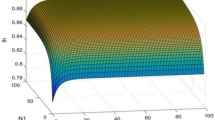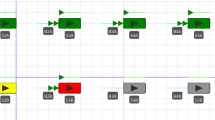Abstract
We compare the optimal buffer allocation of a manufacturing flow line operating under three different production control policies: installation buffer (IB), echelon buffer (EB), and CONWIP (CW). IB is the conventional policy where each machine may store the parts that it produces only in its immediate downstream buffer if the next machine is occupied. EB is a more flexible policy where each machine may store the parts that it produces in any of its downstream buffers. CW is a special case of EB where the capacities of all buffers, except the last one, are zero. The optimization problem that we consider is to maximize the average gross profit (AGP) minus the average cost (AC), subject to a minimum average throughput constraint. AGP is defined as the average throughput of the line weighted by the gross marginal profit (selling price minus production cost per part), and AC is the sum of the average WIP plus total buffer capacity plus transfer rate of parts to remote buffers, weighted by the inventory holding cost rate, the cost of storage space, and the marginal cost of transferring parts to remote buffers, respectively. Numerical results show that the optimal EB policy generally outperforms the optimal IB and CW policies. They also show that as the production rates of the machines decrease, the relative advantage in performance of the EB policy over the other two policies increases. When the cost of transferring parts to remote buffers increases, the dominance of the EB policy over the IB policy decreases while the dominance of the EB policy over CW increases.






Similar content being viewed by others
References
Alfieri A, Matta A (2012) Mathematical programming formulations for approximate simulation of multistage production systems. Eur J Oper Res 219(3):773–783
Alfieri A, Matta A (2013) Mathematical programming time-based decomposition algorithm for discrete event simulation. Eur J Oper Res 231(3):557–566
Altiok T (1997) Performance analysis of manufacturing systems, Springer series in operations research. Springer, New York
Biller S, Li J, Meerkov SM (2009) Bottlenecks in Bernoulli serial lines with rework. IEEE Trans Autom Sci Eng 7(2):208–217
Bonvik AM, Couch CE, Gershwin SB (1997) A comparison of production-line control mechanisms. Int J Prod Res 35(3):789–804
Chan WKV, Schruben L (2008) Optimization models of discrete-event system dynamics. Oper Res 56(5):1218–1237
Demir L, Tunali S, Eliiyi DT (2014) The state of the art on buffer allocation problem: a comprehensive survey. J Intell Manuf 25(3):271–392
Diamantidis AC, Papadopoulos CT (2004) A dynamic programming algorithm for the buffer allocation problem in homogeneous asymptotically reliable serial production lines. Math Probl Eng 3:209–223
Enginarlar E, Li J, Meerkov SM (2005) How lean can lean buffers be? IIE Trans 37(4):333–342
Framinan JM, González PL, Ruiz-Usano R (2003) The CONWIP production control system: Review and research issues. Prod Plan Control 14(3):255–265
Gaury EGA, Pierreval H, Kleijnen JPC (2000) An evolutionary approach to select a pull system among Kanban, Conwip and Hybrid. J Intell Manuf 11(2):157–167
Gershwin SB, Schor GE (2000) Efficient algorithms for buffer space allocation. Ann Oper Res 93(1):117–144
Gstettner S, Kuhn H (1996) Analysis of production control systems kanban and CONWIP. Int J Prod Res 34(11):3253–3273
Helber S (2001) Cash-flow-oriented buffer allocation in stochastic flow lines. Int J Prod Res 39(14):3061–3083
Helber S, Schimmelpfeng K, Stolletz R, Lagerschausen S (2011) Using linear programming to analyze and optimize stochastic flow lines. Ann Oper Res 182(1):193–211
Koukoumialos S, Liberopoulos G (2005) An analytical method for the performance evaluation of echelon kanban control systems. OR Spectr 27(2–3):339–368
Kramer SA, Love RF (1970) A model for optimizing the buffer inventory storage size in a sequential production system. AIIE Trans 2(1):64–69
Lavoie P, Gharbi A, Kenne J-P (2010) A comparative study of pull control mechanisms for unreliable homogeneous transfer lines. Int J Prod Econ 124(1):241–251
Levantesi R, Matta A, Tolio T (2001) A new algorithm for buffer allocation in production lines. In: Proceedings of the 3rd Aegean international conference on design and analysis of manufacturing systems, May 19–22, Tinos Island, Greece, pp 279–288
Li J, Meerkov SM (2000) Production variability in manufacturing systems: Bernoulli reliability case. Ann Oper Res 93(1):299–324
Li J, Meerkov SM (2009) Production systems engineering. Springer, New York
Liberopoulos G (2018) Performance evaluation of a production line operated under an echelon buffer policy. IISE Trans 50(3):161–177
Liberopoulos G, Dallery Y (2000) A unified framework for pull control mechanisms in multistage manufacturing systems. Ann Oper Res 93(1–4):325–355
Meerkov SM, Zhang L (2008) Transient behavior of serial production lines with Bernoulli machines. IIE Trans 40(3):297–312
Meerkov SM, Zhang L (2011) Bernoulli production lines with quality–quantity coupling machines: monotonicity properties and bottlenecks. Ann Oper Res 182(1):119–131
Mitra D, Mitrani I (1989) Control and coordination policies for systems with buffers. Perform Eval Rev 17(1):156–164
Shi C, Gershwin SB (2009) An efficient buffer design algorithm for production line profit maximization. Int J Prod Econ 122(2):725–740
Shi C, Gershwin SB (2014) A segmentation approach for solving buffer allocation problems in large production systems. Int J Prod Res 54(20):6121–6141
Smith JM, Daskalaki S (1988) Buffer space allocation in automated assembly lines. Oper Res 36(2):342–358
Spearman ML, Woodruff DL, Hopp WJ (1990) CONWIP: a pull alternative to Kanban. Int J Prod Res 28(5):879–894
Spinellis D, Papadopoulos C, Smith JM (2000) Large production line optimization using simulated annealing. Int J Prod Res 38(3):509–541
Tan B (2015) Mathematical programming representations of the dynamics of continuous-flow productions systems. IIE Trans 47(2):173–189
Tempelmeier H (2003) Practical considerations in the optimization of flow production systems. Int J Prod Res 41(1):149–170
Van Ryzin G, Lou SXC, Gershwin SB (1993) Production control for a tandem two-machine system. IIE Trans 25(5):5–20
Weiss S, Stolletz R (2015) Buffer allocation in stochastic flow lines via sample-based optimization with initial bounds. OR Spectr 37(4):869–902
Weiss S, Schwarz J, Stolletz R (2018) The buffer allocation problem: formulations, solution methods, and instances. IISE Trans. https://doi.org/10.1080/24725854.2018.1442031
Acknowledgements
This research has received funding from the EU ECSEL Joint Undertaking under Grant Agreement No 737459 (project Productive4.0) and from the General Secretariat of Research and Technology of Greece’s Ministry of Education and Research.
Author information
Authors and Affiliations
Corresponding author
Additional information
Publisher's Note
Springer Nature remains neutral with regard to jurisdictional claims in published maps and institutional affiliations.
Appendices
Appendix 1: Numerical tests for the 8-machine line verifying the concavity of the net average profit under the EB policy
Tables 12, 13, 14, 15, 16, 17, 18, 19, 20, 21 and 22 present the buffer capacity designs under the EB policy that resulted in each iteration of the two-phase optimization algorithm, for scenarios \(L_{1} ,T_{3} ,\) and \(O_{1}\)–\(O_{11}\) of the 8-machine line. Each row shows the iteration number, the buffer capacity design at that iteration, and the eigenvalues corresponding to the Hessian matrix of partial derivatives of the average net profit with respect to the buffer capacities at that design. The buffer capacity design in the last row of each table is the optimal design shown in Table 8. In all cases, all the eigenvalues of the Hessian matrix are negative, indicating that the average net profit at the buffer capacity designs examined is concave.
Appendix 2: Additional numerical results for the 20-machine line with randomly chosen input parameters
Table 23 shows the randomly generated parameter values for instances 41–80 of the 20-machine line, and Table 24 and shows the optimization results for all these instances.
Appendix 3: Numerical results for the 8-machine line with base production probabilities 0.4 and 0.8
Table 25 shows eight additional scenarios for the production rates of the 8-machine flow line example considered in Sect. 6.2. These scenarios are denoted \(L_{5} , \ldots ,L_{12}\) and are similar to scenarios \(L_{1} , \ldots ,L_{4}\) shown in Table 5, except that they use a different base production probability than 0.6, which is used in scenarios \(L_{1} , \ldots ,L_{4}\). More specifically, scenarios \(L_{5} , \ldots ,L_{8}\) use base production probability 0.4, while scenarios \(L_{9} , \ldots ,L_{12}\) use base production probability 0.8. As in Table 5, the production probabilities of the slowest machine in scenarios L6-L8 and L10-L12 are shown bold.
We solved problem (1)-(2) for all combinations of scenarios L5–L12, T1–T3, and O1–O11, i.e., for a total of \(8 \times 3 \times 11 = 264\) instances. Tables 26, 27, 28, 29, 30, 31, 32 and 33 show the optimization results for all these instances.
Rights and permissions
About this article
Cite this article
Liberopoulos, G. Comparison of optimal buffer allocation in flow lines under installation buffer, echelon buffer, and CONWIP policies. Flex Serv Manuf J 32, 297–365 (2020). https://doi.org/10.1007/s10696-019-09341-y
Published:
Issue Date:
DOI: https://doi.org/10.1007/s10696-019-09341-y




